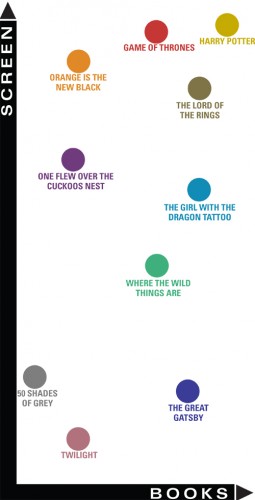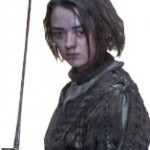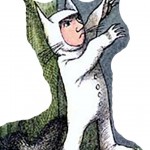The film industry has always used books as sources for movie ideas, but the adaptations have not always been successful

Movies are works that can expose viewers to things they have never seen and transport them to worlds they could have never imagined, but in many cases an author has already created the imaginary world. Earlier films were adapted from plays, but as time went on they have been more frequently adapted from novels.
Although it seems that some books were written to be made into films, like the trend-following book series “Divergent” and “The Maze Runner,” which are part of the dystopian trend in young-adult literature currently, Rebecca Johns-Trissler, a DePaul English professor argues that this is a bad way to write a book.
“Writing for trends is the kiss of death—you always want to be the first person to create the trend; everyone else seems like a pale imitation afterward,” Johns-Trissler said.
“Other writers start thinking they should all pile on the bandwagon. And it lasts for a little while, but then readers get tired of the same thing over and over,” Johns-Trissler said.
The notion that viewers will move on from trends leads to questions about the longevity of established movie series that are based on trends, such as the Marvel Cinematic Universe, and trending dystopian movie series.
Movie adaptations have been around since the beginnings of cinema, and include film classics such as “Casablanca” and “The Godfather.” The Academy Awards also has a category for adapted works, celebrating the writers who have taken a novel, play or even other films and have made them their own by awarding them the Academy Award for Best Adapted Screenplay. One of the most recent nominees in that category was “Inherent Vice,” originally a novel by Thomas Pynchon.
“I saw the film first, then read the novel and then saw the film a second time,” DePaul student Jordan Brash said. “I had been meaning to read the novel for the longest time and this was an opportunity to start.”
He complimented how the film was able to be faithful to the original work, but be a creative work at the same time.
“‘Inherent Vice’ is about as faithful as it could possibly be given the amount of characters and plot contrivances in the novel,” Brash said. “I really love that they kept all of the fascinating details of the novel, like Mickey’s tie collection or Bigfoot eating frozen bananas, while still finding a way to tie them into the physical comedy of the film.”
Although books become beloved creative works that fans are excited to see on the screen, film producers adapt books for economic reasons, rather than creative possibilities.
“Media producers have long-preferred to make films and TV shows out of what are called pre-sold properties,” said Blair Davis, a Media and Cinema Studies professor who teaches a class on adaptations at DePaul. “Because the material exists in another form already, audiences are familiar with the basic premise and characters, and will presumably want to follow them over to a new medium.”
This familiarity has helped adapted works become some of the highest-grossing films of all time. Out of the top 10 highest-grossing film series, seven have been adapted from books or comic books including the Harry Potter series which has grossed $7,723,431,572 in eight films, the Marvel Cinematic Universe which has grossed $7,160,192,712 in 10 films, and “The Lord of the Rings” and “The Hobbit” films which grossed $5,880,462,582 in seven films.
A more recent medium in which adaptations have been based is television. HBO series such as “Game of Thrones” and “The Casual Vacancy” have both been adapted from highly successful books.
“TV can take far more time to tell the same story as a film,” Davis said. “A television adaptation often created additional aspects to supplement that story further.”
Many of the most successful movie franchises have been based off of series whose target audiences are children, such as Harry Potter and “The Chronicles of Narnia.”
DePaul student Andrew Hutchinson has been a fan of “The Chronicles of Narnia” since he was in the second grade. When Walden Media started creating movies based off the series, Hutchinson made sure to see them.
“I think they are good movies because they use what was once a classic part of my own childhood and bring them to vivid life on the big screen,” Hutchinson said.
While some adaptations have been criticized for leaving plot details, such as “Game of Thrones,” which in the past season excluded the character of Lady Stoneheart, some fans argue this makes for a better adaptation.
“Bad adaptations are usually ones that stick too closely to the book, ironically enough,” Johns-Trissler said. “Screenwriters and directors need to have the freedom to work in their respective media if the story is going to be successful.”
By sticking to the same format as their book counterparts, adaptations can become boring repetitions of their predecessor.
“When people tell me they want faithful adaptations, I’m like ‘Why do you want your art to be boring?’” Brash said.
Not allowing film directors to take creative liberties is what can result in an unsuccessful film adaptation.
“There’s not much point seeing a film based on a book if it doesn’t try to use film form effectively in translating words into compelling images,” Blair said.
For as long as cinema has existed, books have been sources to adapt from, but it’s exciting to see the creativity that filmmakers use to create a work of their own.

50 Shades of Grey
Originally a “Twilight” fan fiction, “50 Shades of Grey” has become a phenomenon with the book selling over 100 million copies, and the film making over $500 million. The dialogue is written so horribly and awkwardly, it becomes impossible to imagine Anastasia Steele, and the psychopathic Christian Grey as actual characters. It gets to the point where the reader begins to wonder if author E.L. James has ever seen actual humans interact with one another. Beyond how unbearably awkward the writing is, to the point where it is comedic, it’s essentially the story of a woman being abused by a stalker. The film is significantly better than the joke of a novel. The characters are still painfully awkward, but they seem like actual human beings. The best thing about the adaptation is Dakota Johnson’s portrayal of Anastasia. She brings life to a character who could not have been written more boring.

Game of Thrones
The hit HBO show which returned for its fifth season last night, and has become one of HBO’s most successful shows. Each season is an adapted version of a book in George R.R. Martin’s fantasy series “A Song of Fire and Ice.” The five-part book series is an immensely detailed historical fantasy series, which bases a lot of its content off of British and Roman history. The books are seen as a modern fantasy masterpiece. Despite the high praise, the show is even better than the book series. Each hour-long episode picks up on the most important plot points, and cuts out some of the immense amount of details that Martin includes to maintain a fast-paced, exciting show. “Game of Thrones” has done a good job at distinguishing itself from the book series as well. Martin is still in the process of writing, and so the executive producers have to make decisions on how the story will go without source material.

Where the Wild Things Are
In 1963, Maurice Sendak wrote and illustrated the classic children’s picture book “Where the Wild Things Are.” It follows an imaginative, but trouble-making young boy in a wolf suit, Max, as he travels to a jungle and encounters creatures referred to as Wild Things. It’s interesting to see the creative liberties that director Spike Jonze took in making the film, as he adapted it from a book with less than 40 pages and only 338 words. The characters are far more developed in the film, especially the Wild Things, as each is given a name and personality traits. Max also develops a close friendship with the Wild Things and K.W. Carol, who come to represent Max and his mother. The film drags at points, but it’s impressive to see what Jonze did with such limited source material.

The Great Gatsby
As one of the most famous American novels, “The Great Gatsby” has been adapted into several different mediums, including a ballet and seven film adaptations. One of the most recent was starring Leonardo DiCaprio as Gatsby. The book follows the narrator Nick Carraway, played by Tobey Maguire in the film, as he moves next to the incredibly wealthy, non-stop partying Jay Gatsby. It’s revealed that Gatsby throws so many parties in an attempt to impress Daisy, the love of his life, who he has not seen in years. Although the book was unsuccessful when it was first published in 1925, it’s now regarded as a classic novel. The film is less memorable. The cinematography in the film is remarkable, but the plot falls flat, and is overall a flashy and beautiful but boring film.

Harry Potter
Arguably one of the most beloved book series ever written, the seven-book story follows orphan Harry Potter as he finds out he is a wizard, and begins school at Hogwarts School of Witchcraft and Wizardry. After finding out he is a wizard, he has to face off against evil teachers, dreaded homework and the most evil wizard of all time — Lord Voldemort. Written by J.K. Rowling, the books have sold over 450 million copies, according to the BBC. The book series is one of the most incredibly imaginative and brilliant series in recent years, and the movies that accompany it are just as great. The films set the standards for how adaptations should be made, as each of the four directors who worked on the eight films took their own creative liberties, but at the same time, made sure not to stray too far from the series that fans fell in love with.

Orange is the New Black
Some people consider an adaptation a failure if it strays from the source material, but the Netflix show “Orange is the New Black” is anything but a failure. The show is based on Piper Kerman’s memoir “Orange is the New Black,” based on her time in prison on felony money-laundering charges. Kerman retraces her steps through prison and before, to explain what she did and how she was caught. The majority of the focus throughout the memoir is on Kerman, unlike the show. While Piper Chapman (the character based on Kerman) is the main character in the television adaptation, there are numerous other characters as well. Kerman’s memoir touches on some of these, with their names changed, such as Pop (Red on the show) and Nora (Kerman’s ex-girlfriend, named Alex on the show), but for the most part, all of the characters on the television show are entirely new, and the show is better for it. The memoir drags at parts, while the show is constantly exciting and thought-provoking.


JJ • Apr 20, 2015 at 1:18 pm
Book to movie adaptations have trouble succeeding if the casting is off from what fans envisioned in their minds. The Bookcaster is a website that is working to change that.